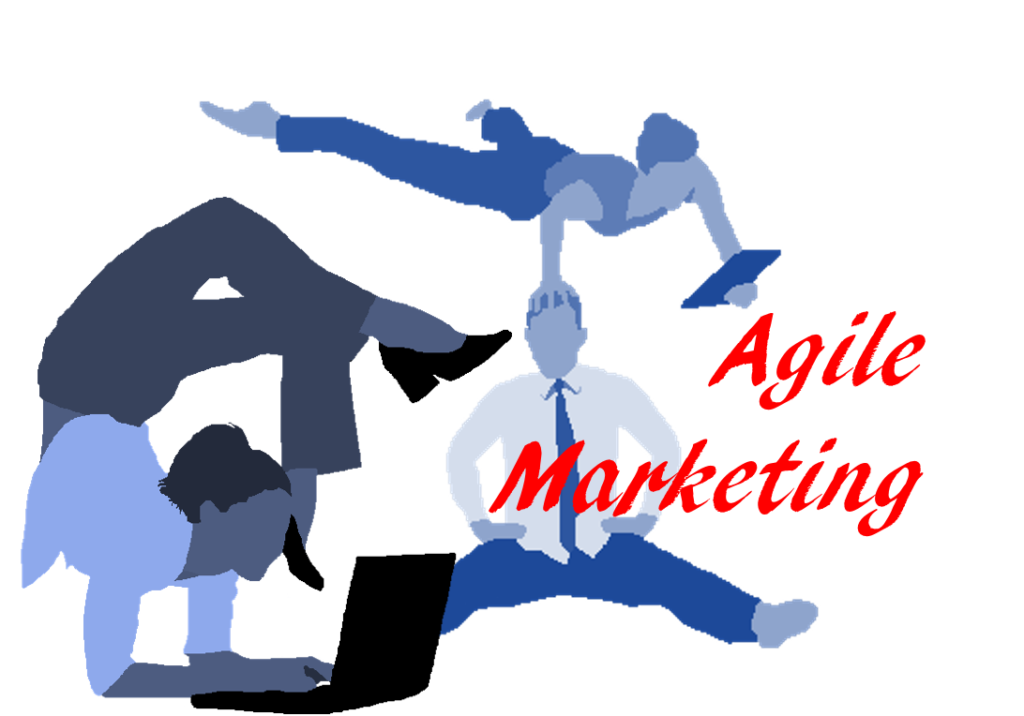According to Scott Brinker (@chiefmartec), co-founder & CTO of ion interactive, today’s digital path to purchase requires marketers to create great customer experiences for a variety of consumers across multiple channels. This means marketers must deal with faster cycle speeds, fragmented channels, numerous feedback loops, and frequent disruptions.[1] He suggests the best approach for dealing with this complex challenge is to implement agile marketing. James A. Martin (@James_A_Martin) defines agile marketing as “a process in which the marketing workflow is broken into smaller chunks and experiments, traditional silos between departments are removed, and customer and transaction data is shared across teams and disciplines. The end goal is to rapidly respond to changing market conditions, new data and new forms of customer engagement with tightly focused, targeted marketing. Ultimately, agile marketing is about consistently and quickly delivering a superior customer experience across multiple channels.”[2] These ideas should come as no surprise. In almost every aspect of business management you hear some of the same recommendations: act more quickly, leverage big data analytics, and break down organizational silos. Brinker asserts advanced analytics are required by today’s marketers because “marketing used to be complicated — now it is complex.”
He points to a study by the Boston Consulting Group that concludes some of today’s most successful companies “compete in a fundamentally new way. They leverage evolvable algorithms, which self-tune to accumulated knowledge and changing circumstances. These are the algorithms that, for example, select ads when a customer books a flight online and create offers for similar flights and for related destinations, hotels, and cars. The algorithms’ recommendations are seamlessly updated when the customer researches alternatives. And the algorithms learn from established patterns for future reference. In essence, evolvable algorithms allow these companies to balance broad, economical, and fast exploration of new opportunities with the exploitation of existing known ones, helping the companies thrive under conditions of high uncertainty and rapid change in their online businesses.”[3] In other words, these companies are successful because they are agile. Being agile doesn’t mean dumping structure altogether. Zack Kinsley notes that agility can be enhanced by implementing technologies developed to deal with complexity. He explains, “Marketing is all about creating great content that educates and builds relationships. These days customers need to be nurtured with new content repeatedly for duration of time. The days of impulse buying are disappearing, and those customers are no one’s true target customer. Automation tools are the key to managing this task effectively.”[4]
Martin reports speakers at a March 2016 Martech conference reiterated the importance of agility in today’s marketing environment. Barre Hardy (@barreblake), associate partner at CMG, told participants, “Agile marketing is about making organizations great at learning as much about their customers as quickly as possible.” David Lesué (@davidlesue), Creative Director at Workfront, added, “Agile marketing is about communicating with your target audience, tailoring your marketing efforts to them, and adapting those efforts [as needed, as fast as possible].” Martin notes that even though agile marketing is a concept that is just beginning to flourish it has been incubating for over a decade. He reports, “Several high-tech marketers began experimenting with agile techniques in the early-mid 2000s.” Agile marketing has become a “real thing,” as Martin puts it, because supporting technologies have now matured enough to make it possible. The development of these technologies can be tied to the rise of the digital age and, more recently, the incredible penetration of mobile technologies around the globe. Although the internet and desktop PCs introduced consumers to the digital path to purchase, mobile technologies, especially smartphones, dramatically changed shopper behavior. Marketers have been desperately trying to catch up and agile marketing offers them the best hope of doing so. As Brinker puts it, “Marketing has shifted from the business of communications to the business of experiences. It’s the experiences that we give our prospects and customers, from their very first touchpoint with us onward, that ‘communicates’ our brand. And in a digital world, almost all of those experiences are mediated by software.”[5]
Lying at the heart of agile marketing (and the digital path to purchase) is data and its analysis. In another article Martin notes, “Enterprises today accumulate a lot of data, which they typically use internally for CRM, sales forecasting, and marketing strategies, among other things. But some savvy companies, particularly those in the technology industry, share this data with the media and the world at large. The benefits of data-driven content marketing can be considerable.”[6] He goes on to offer eight tips and best practices for data-driven marketing. They are:
1. Marketing collaboration with IT is key.
2. Make sure data is accurate.
3. Plan marketing data projects well in advance.
4. Focus, don’t try to do too much with data.
5. Develop strong relationships with media and analysts.
6. Prioritize data for marketing vs. product growth.
7. If you don’t already have data, create it.
8. Don’t forget the target audience.
Although “planning marketing data projects well in advance” and “avoiding trying to do too much with data” may seem like conflicting principles to those associated with agile marketing, they aren’t. Getting the data right actually improves one’s ability to deal with faster cycle speeds, fragmented channels, numerous feedback loops, and frequent disruptions. “With technology driving so much rapid change,” Martin writes, “marketing organizations today need to be ready to spring into action or change course at a moment’s notice.” That’s not possible if the right data isn’t being analyzed. Kinsley adds, “Automation in digital marketing is a must! Just like automation is being incorporated into most aspects of the business world. The key to marketing automation is still keeping a personality in the messaging and defining your goals clearly.” To highlight just how quickly marketers should be ready to act, Martin points an incident that occurred during the 2013 Super Bowl.
“On February 3, 2013, a power outage hit the Mercedes-Benz Superdome in New Orleans during the Super Bowl. The digital marketing agency behind Nabisco’s Oreo cookie, 360i, reportedly designed, captioned, approved and posted to Twitter and Facebook within minutes an image of an Oreo cookie illuminated with what looked like a lantern or flashlight beam. The image, posted to the @Oreo Twitter account, featured the caption: ‘Power out? No problem. You can still dunk in the dark.’ The tweet was retweeted more than 14,000 times and earned more than 20,000 likes on Facebook. BuzzFeed raved that the tweet was ‘perfectly zeitgeisty’ and was ‘the most powerful bit of marketing during the advertising industry’s most expensive day’.”
The digital age requires agile solutions. That’s as true in the marketing arena as in all other business arenas. Brinker concludes, “I’m convinced that adopting agile is the single best thing a company can do to improve its results in conversion optimization. … Adopting an agile methodology — frankly, any agile methodology — forces you to break old patterns and consciously rethink how you’re doing things, not just what you’re doing. A good agile methodology forces you to act differently, as a catalyst for learning to think differently. Only once you’ve broken the stranglehold of existing habits are you free to start inventing new ones. But, hey, you don’t have to do that. As W. Edwards Deming noted, ‘It is not necessary to change. Survival is not mandatory.'”[7]
Footnotes
[1] Scott Brinker, “Everything you wanted to know about agile marketing (but were afraid to ask),” Chief Marketing Technology Blog, 8 April 2014.
[2] James A. Martin, “What is agile marketing and should you be sprinting to it?” CIO, 15 April 2016.
[3] Martin Reeves, Ron Nicol, Thijs Venema, and Georg Wittenburg, “The Evolvable Enterprise: Lessons from the New Technology Giants,” bcg.perspectives, 19 February 2014.
[4] Zack Kinsley, “3 Reasons Why Automation Is A Must For Your Digital Marketing,” Business 2 Community, 1 April 2016.
[5] Scott Brinker, “Marketing as UX incarnate, with agile and lean principles,” Chief Marketing Technology Blog, 16 February 2015.
[6] James A. Martin, “How to do data-driven marketing right,” CIO, 6 April 2016.
[7] Scott Brinker, “Agile marketing? That would never work here,” Chief Marketing Technology Blog, 5 September 2014.





